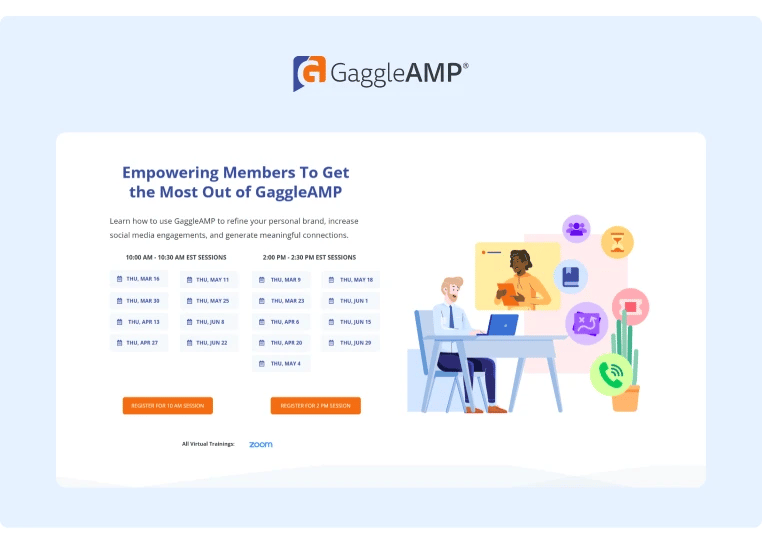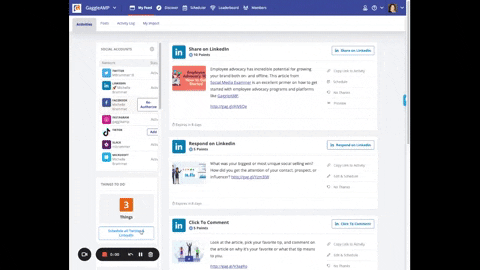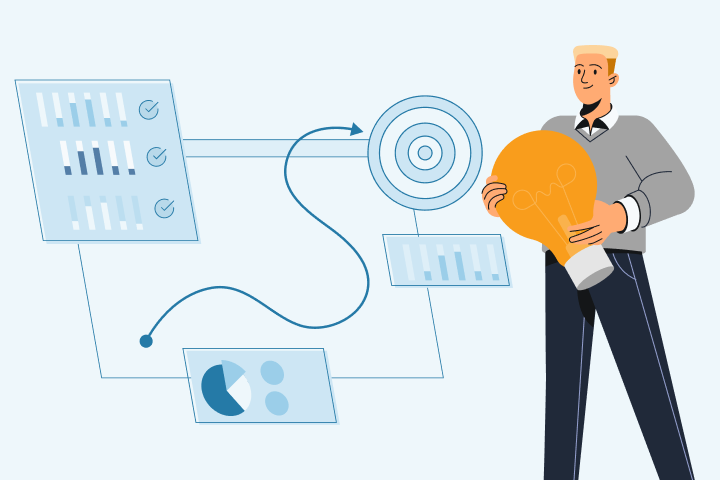5 Employee Advocacy Best Practices That All Marketers Need To Know
Employee advocacy is based on a fundamental principle - consumers trust people over brands.
While you may have established a well-loved and instantly-recognizable brand, it cannot earn the same level of trust as a personal connection. By implementing an employee advocacy program, you can leverage your employees’ existing connections to humanize your brand and potentially grow your brand’s reach.
Whether you’re building an employee advocacy program from scratch, or want to boost your existing program, you’re in the right place. Our complete guide to employee advocacy will help you understand how it works and its benefits, give you employee advocacy examples, and highlight five best practices that all marketers need to know.
First, let’s define what employee advocacy is.
What Is Employee Advocacy?
Employee advocacy is the promotion of a business by its employees. Most modern advocacy programs rely on social media platforms to promote an organization. Employees share, engage with, and even create brand-related content, effectively becoming ambassadors of the organizations they work for. This helps humanize the brand and reach a broader audience, bringing it closer to the end customer.
Advocacy programs consist of employees sharing three types of messaging:
-
Information about the business’s products or services.
-
Content that benefits the brand’s partners or target audience.
-
Insight into the company culture, principles, and goals.
Sounds pretty straightforward, right?
True, but there’s a lot more to understand before you can successfully implement an employee advocacy social media plan. Before we get into further details of the process, let’s look at the benefits of employee advocacy.
What Are the Benefits of Employee Advocacy?
If you’re still asking yourself, “Why is employee advocacy important?” Almost half the respondents (46%) surveyed for Oktopost’s State of B2B Social Media Marketing Report named employee advocacy the best-performing social media initiative. Beyond building and expanding brand awareness, employee advocacy has grown as a reliable sales tool and is a proven strategy that adds value across the entire customer journey.
Let’s take a look at some of the biggest benefits of implementing an employee advocacy program:
Benefits for Employers

From boosting brand awareness and building consumer trust to attracting top talent, employee advocacy platforms have several advantages for the employer. Here are three ways employee advocacy can help:
1. Increase the Brand’s Reach and Engagement
Active and engaged employees can help your brand messaging reach wider audiences. After launching a formal employee advocacy program, 79% of businesses reported increased brand visibility, and 65% of companies said it helped boost brand recognition.
Additionally, the value of employee posts increases further if they are personalized by employees. According to PostBeyond, personalized posts generate 64% more engagement than generic posts.
Let’s say your business has 50 employees. If each of these employees has a network of 500 people, with just 10 personalized employee posts shared a month, they can give you access to up to 250,000 touchpoints!
The greatest benefit of employee advocacy is the credibility it gives your brand. By enabling your employees to humanize an impersonal organization, your brand appears more relatable and trustworthy. In turn, your brand’s reach and engagement has the potential to soar.
2. Grow the Business
The influence of user-generated content (UGC) on purchasing decisions is higher than ever. And who is better than your employees to generate buzz about your organization? 79% of shoppers say UGC content impacts their purchasing decisions compared to brand-created content (12%) or influencer-created content (9%). So, when your employees create and publish content for your organization, they have the potential to directly boost sales and help your business grow.
@the_tim_davidson "Tradebooths are worthless" - @nickb_2005 Events can be a killer part of your marketing strategy. It's just that most orgs do it wrong. You can't just pay unfathomable amounts of money on a booth, give out pens, socks and Gildan T-Shirts (Get the good brands would ya!) and scan badges and then start them on a 163 point email nurture cadence. Events can work but it has to be part of your overall strategy. #b2bsales #b2bmarketing #techsales #demandgeneration #b2bsaas #saasmarketing #eventmarketing ♬ HEYYY WAIT A SECOND - THEREALFIERY
Tim Davidson films TikTok videos directed at B2B companies, the ideal client for his company, Directive.
3. Attract and Retain Top Talent
Individuals want to work for businesses that align with their ideals and goals. 56% of US employees say they wouldn’t even consider working at a company whose values do not agree with theirs. The best way to inform potential employees about your brand’s principles is through social media posts by current employees. These posts can give potential candidates a transparent and authentic insight into your work culture, helping to attract the right talent.
Moreover, employees who feel connected and engaged with the business are more likely to stay in their roles longer. You can reduce turnover and retain your best talent by giving employees a sense of ownership and participation toward the company’s goals.
Benefits for Employees
Since an advocacy program requires employees to do some work, it makes sense to include some attractive benefits. Here are some of the ways in which a well-thought-out advocacy program can benefit employees.
1. Establish a Social Media Presence
An employee advocacy LinkedIn program can help employees boost their own social media presence. As employees share their expertise on industry related trends and relevant topics, they’ll earn credibility and over time establish themselves as thought leaders. Plus, they may form connections with others in their industry to make content that resonates with their joint audiences. In turn, they’ll expand their professional network as their followers and connections grow. Employee advocacy program examples are all over LinkedIn, like this post from Arthur Castillo of Chili Piper.
2. Get Better at Their Roles
Employee advocacy can also benefit an employee’s professional growth within an organization. Employees who create brand-related content will develop a more nuanced understanding of their organization’s values, goals, and processes. This information can potentially help them improve their job performance. An employee advocacy program can also help give them a working knowledge of your company’s other departments and promote intra-organizational bonding.
5 Best Practices for Effective Employee Advocacy
It’s hard to ignore the many advantages of an employee advocacy program. So, if your organization doesn’t have one in place yet, you shouldn’t delay it further.
Confused about how to get started? Here are five tips to create an effective employee advocacy program.
1. Build a Positive Workplace Culture
Your employees will only be willing to advocate for the organization if they feel good about their jobs and the work that they do. Prioritize building a culture of honesty, respect, and well-being at your company, where employees feel supported and valued. This goes beyond offering competitive compensation. Spend time understanding your employee’s expectations and identifying areas where you can improve.
2. Create a Training Program
Remember, not all of your employees are social media experts; some could use guidance on creating and sharing content. Many of them may not know what constitutes an employee advocate’s role. You should create an employee advocacy training program to help individuals understand expectations and learn the tips and tricks for different social media accounts such as LinkedIn best practices for employees.

GaggleAMP hosts Member training programs to help Members get the most out of their employers’ employee advocacy program.
Set clear policies regarding the employee advocacy program that must be adhered to. For example, under no circumstances should an employee post confidential company information online, and neither can they make statements on behalf of the organization. If an employee is unsure whether a piece of content is appropriate, it’s best to have them ask their manager before publishing it.
3. Incentivize Employees to Participate
While offering monetary incentives for hitting goals such as 10 monthly posts shared or 100 likes gained may be tempting, these aren’t always effective. Instead, incentivizing employees with recognition, both internal and external, can often produce the best outcomes. Help employees understand how an advocacy program can benefit their profile profiles while also offering recognition within the company for their efforts.
Make sure your employees understand that participation is not compulsory, and they will not be penalized if they choose not to share brand-related posts on social media.
4. Set Goals and Track Progress
To measure the success of your employee advocacy strategy, you need to set clear goals and key performance indicators (KPIs). Your targets can include business goals such as increasing visitors to the company website by 20% in the next six months or hiring five new employees per quarter. You can also focus on social media-specific targets, such as having 45% of your total employees participate in your advocacy program.
5. Use Employee Advocacy Tools
The quickest and most convenient way to get your employees active on social media is by taking advantage of employee advocacy tools. GaggleAMP’s employee advocacy program makes it easy for your employees to share content and engage with posts through their personal social media accounts on LinkedIn, Twitter, Facebook, Instagram, and more! The Gaggle Manager simply creates content for the Gaggle Member to engage with, and with very little effort, they can share posts to their accounts.

You’ll also get access to in-depth analytics and dashboards to measure the program's success and tweak your strategy for the best results. Moreover, you can increase participation and engagement with the gamification of employee advocacy.
Ready to Start Your Employee Advocacy Strategy?
Ready to streamline your employee advocacy strategy, boost your brand’s presence, and attract the best employees? Request a demo to see how GaggleAMP helps boost reach and engagement for brands of all sizes and industries.











